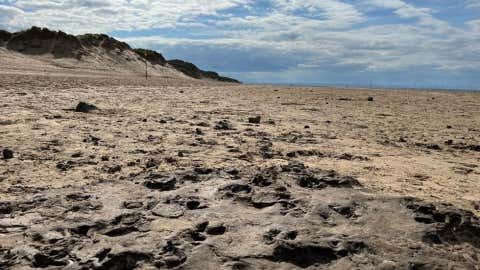Ancient ‘Superhighway’ Full of Human and Animal Footprints from Different Eras Discovered At a UK Beach (PHOTOS)

When walking along a tranquil beach leaving behind footprints in the sand, have you ever wondered how many people may have walked the same paths, their tracks washed away by the waves? What if their footprints were preserved beneath the sands of time for thousands of years, only to reveal themselves out of nowhere?
Researchers at the University of Manchester have discovered one such coastal superhighway of some brilliantly-preserved human and animal footprints on Formby beach, Merseyside, UK. Some of them date back to the middle stone ages (15,000 BC to 50 BC), while others are as recent as the medieval era (476 AD 1450 AD).
What’s so unique about these footprints?

These tracks were first discovered in the 1970s, but they only gained importance in the 1990s, when a retired teacher began dating them after "realising that they were of some antiquity. Before then, people didn't think the prints were particularly interesting or old," said Alison Burns, a co-author of the paper.
While footprint tracks have also been discovered in several other places in the world, the Formby footprint beds form one of the world’s largest known concentrations of prehistoric Holocene vertebrate tracks.
Moreover, these tracks go beyond being a simple record at a single site. In fact, they tell us the exciting story of how the ecosystem and landscape have evolved in the area and how humans and animals have co-existed in this intertidal environment for thousands of years.
Evolution of a biodiversity hotspot, etched in sand

In total, a dozen "well-preserved" footprint beds — some of which are stacked on top of each other — are being revealed as coastal waters erode their protective layers with the waves. Their ages have been determined via radiocarbon dating.
The oldest beds, towards the south of Formby Point, are from the Mesolithic age from about 8,000 years ago. As the boundaries between the land and sea shifted after the last ice age (between 9,000-6,000 years ago), humans and animals moved inland to resource rich areas like the Merseyside beach. Along with human footprints, the study also found traces of other large mammals like aurochs (an extinct ox species), red deer, roe deer, wild boar and beaver, along with predators like wolf and lynx.
But some changes become apparent as we move towards the newer beds of the early neolithic age. During this time, the area appears to have gone through a profound change socially and ecologically with the introduction of agriculture in the British Isles. This is observed in the form of a striking change reflected in the dominantly appearing human footprints and a fall in mammalian species diversity.

This shift in species composition could be attributed to habitat fragmentation and land use changes that might have occurred alongside the development of agricultural societies. There are also wooden tracks pointing to evidence of sea journeys and coming up of more permanent settlements.
All of this points to how a rich biodiversity hotspot over years transformed into more of those modern settlements that we see today.
The conclusion of this study transcends that of archeology and geography, and expands upon how sea level rise that threatens island nations and coastal land masses today can irreversibly alter the world and the vital ecosystems that keep our planet going!
The findings of this study were published in the October issue of the journal Nature Ecology and Evolution and can be accessed here.
No comments:
Post a Comment